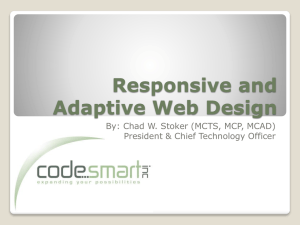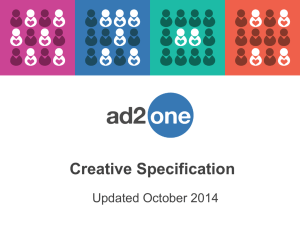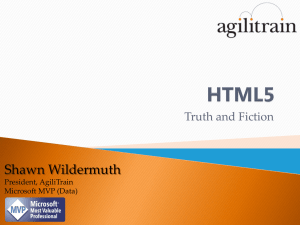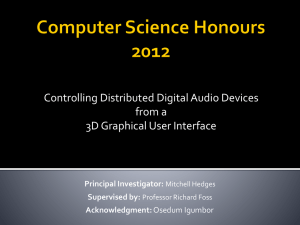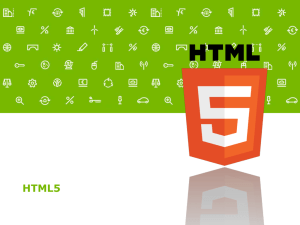video - Netmode
advertisement
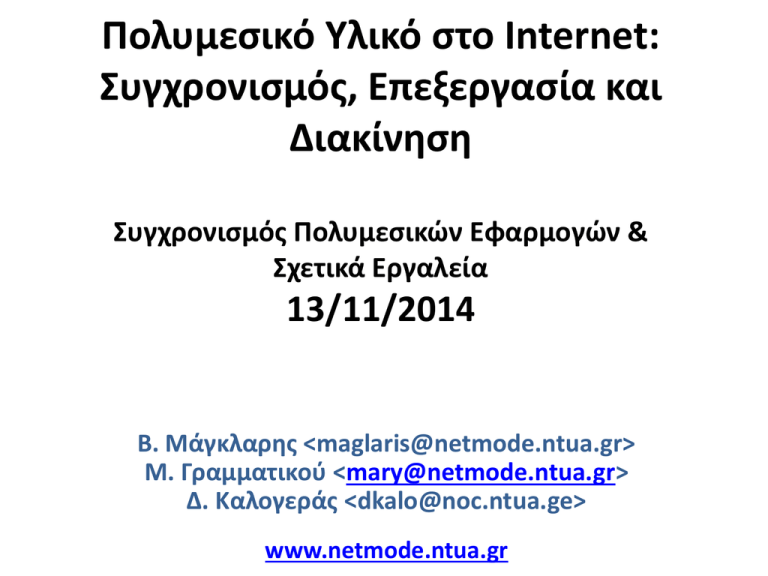
Πολυμεσικό Υλικό στο Internet: Συγχρονισμός, Επεξεργασία και Διακίνηση Συγχρονισμός Πολυμεσικών Εφαρμογών & Σχετικά Εργαλεία 13/11/2014 Β. Μάγκλαρης <maglaris@netmode.ntua.gr> Μ. Γραμματικού <mary@netmode.ntua.gr> Δ. Καλογεράς <dkalo@noc.ntua.ge> www.netmode.ntua.gr Outline • • • • • Real-Time Protocols (RTP, RTCP, RTSP) ITU – H.323 Session Initiation Protocol (SIP) Synchronized Multimedia Integration Language (SMIL) A Rough History of Web Standards – HTML5 – PopcornJS - HTML5 Media Framework – Timesheets.js Real-Time Protocol (RTP) Real-Time Control Protocol (RTCP) http://en.wikipedia.org/wiki/Real-time_Transport_Protocol http://tools.ietf.org/html/rfc1889 https://tools.ietf.org/html/rfc3611 http://en.wikipedia.org/wiki/RTP_Control_Protocol • RTP: first published in 1996 by IETF • RTP: Defines a standardized packet format for delivering audio and video over IP Networks • Real-Time Protocol (RTP) – a framing protocol for real-time applications – there is no QoS in real time based on UDP protocol • RTCP: RTCP protocol monitors transmission statistics and Quality of Service (QoS) and aids synchronization of multiple streams Real Time Streaming Protocol (RTSP) http://en.wikipedia.org/wiki/Real_Time_Streaming_Protocol http://www.ietf.org/rfc/rfc2326.txt • RTSP was developed by RealNetworks, Netscape and Columbia University, with the first draft submitted to IETF in 1996 • RTSP: – an application-level protocol for control over the delivery of data with realtime properties – controls streaming media servers – is used for establishing and controlling media sessions between end points – RTSP servers use the Real-time Transport Protocol (RTP) in conjunction with Real-time Control Protocol (RTCP) for media stream delivery ITU – H.323 http://www.h323forum.org, http://en.wikipedia.org/wiki/H.323 www.rfc-editor.org/info/rfc4123 • First version of H.323 was published by the ITU in November 1996 • Defines the protocols to provide audio-visual communication sessions in any IP (Internet) infrastructure – Point-to-point – Multi-point (Multi-Conference Unit - MCU) • Addresses call signalling and control, multimedia transport and control, and bandwidth control for point-to-point and multi-point conferences • H.323 call signalling – is based on the ITU-T Recommendation Q.931 protocol – is suited for transmitting calls across networks using a mixture of IP, PSTN, ISDN, and QSIG over ISDN • A Gatekeeper is an optional component in the H.323 network that provides a number of services to terminals, gateways, and MCU devices. Session Initiation Protocol (SIP) http://en.wikipedia.org/wiki/Session_Initiation_Protocol https://www.ietf.org/rfc/rfc3261.txt • SIP: a signalling communication protocol, widely used for controlling multimedia communication sessions such as voice and video calls over Internet Protocol (IP) networks • SIP was originally designed by Henning Schulzrinne and Mark Handley in 1996 • Text Based (like HTTP) • SIP address like : user @ host • Same services with Η.323 but : – H.323 MCU as a special purpose component – SIP: server-based multi conference • SDP (Session Description Protocol) for media (audio, video) description Synchronized Multimedia Integration Language (SMIL) http://en.wikipedia.org/wiki/Synchronized_Multimedia_Integration_Language http://www.ietf.org/rfc/rfc4536.txt • SMIL version 1 : introduced 1999 • SMIL: a World Wide Web Consortium (W3C) recommended Extensible Markup Language (XML) to describe multimedia presentations • Defines markup for : – – – – – timing layout animations visual transitions media embedding • Presenting media items (text, images, video, audio, links) to other SMIL presentations, and files from multiple web servers A Rough History of Web Standards (ref) 91-92 93-94 HTML 1 HTML 2 95-96 97-98 99-00 HTML 4 XHTML 1 CSS 1 CSS 2 JS ECMA, DOM 01-02 05-06 07-08 09-10 11-12 13-14 HTML 5 T-less D DOM 2 03-04 Web 2.0 CSS3 Ajax HTML DOM, APIs CSS 2004 WHATWG started 1996 – CSS 1 W3C Rec 2008 W3C Working Draft 1998 – CSS 2 W3C Rec 2012 (2010) W3C Candidate Rec 1999 – CSS 3 Proposed 2022 W3C Rec 2001 – CSS 3 W3C Working Draft 2005 – CSS 2.1 W3C Candidate Rec HTML5: more than HTML • HTML5 Spec • CSS3 (Cascading Style Sheet) Spec • JavaScript to tie it all together What’s new to HTML5 • • • • • • • Simplified and Loose Syntax New Elements and Attributes Embedded Media (audio, video) Canvas Offline Storage Drag and Drop Geo-Location Browser Support http://www.w3.org/TR/html5/ • HTML5 is not yet an official standard browsers have not full HTML5 support • But all major browsers (Safari, Chrome, Firefox, Opera, Internet Explorer) continue to add new HTML5 features to their latest versions HTML5 Video http://en.wikipedia.org/wiki/HTML5_video http://www.w3.org/TR/html5/embedded-content-0.html#the-video-element • HTML5 specification introduced the <video> element, partially replacing the <object> element. • HTML5 video is intended to become the new standard way to show video on the web without plug-ins • The <video> element was proposed by Opera Software in February 2007 HTML5 Video Benefits • End users have full control over the multimedia. – HTML5 video and audio are keyboard-enabled by default, which is a great accessibility benefit. • End users do not need to install a plug-in to play them. – Browser already has everything it needs to play movies/sound. • Video and audio content on the page can be manipulated. – Two new elements that can be styled, moved, manipulated, stacked and rotated. • You can build your own controls using HTML, CSS and JavaScript. – No new skills or development environment needed. • Simple interaction with the rest of the page. – Multimedia API gives you full control over the video, and you can make the video react both to changes in the video itself and to the page around it. Using HTML5 Media Elements https://developer.mozilla.org/en-US/docs/Web/Guide/HTML/Using_HTML5_audio_and_video https://developer.mozilla.org/en-US/docs/Web/HTML/Supported_media_formats <audio src="/test/audio.ogg"> <p>Your browser does not support the audio element.</p> </audio> <video> <source src="somevideo.webm" type="video/webm"> <source src="somevideo.mp4" type="video/mp4"> I'm sorry; your browser doesn't support HTML5 video in WebM with VP8 or MP4 with H.264. <!-- You can embed a Flash player here, to play your mp4 video in older browsers --> </video> HTML5 Video - Codecs that Browsers Support http://en.wikipedia.org/wiki/HTML5_video • MP4 or H.264: codec supported by Apple and Microsoft. Provides good quality video and small file sizes • ogg/Theora: free open standard for video encoding. It generates high quality videos with comparatively larger file sizes. Hard to find tools to convert to ogg/Theora. • WebM: uses the VP8 codec, owned by Google. High video quality, longer to encode than in H.264. Very difficult to encode, especially compared to the many free & commercial tools available for H.264. Adobe – Apple Controversy http://en.wikipedia.org/wiki/Apple_and_Adobe_Flash_controversy https://www.apple.com/hotnews/thoughts-on-flash/ • As of April 2010, in the wake of Apple iPad launch, a number of high-profile sites have started to serve H.264 HTML5 video instead of Flash for user-agents identifying as iPad • On November 8, 2011, Adobe announced that it was ceasing development of the Flash Player "plug-in" for browsers on mobile devices, in an effort to shift its focus on using the ActionScript programming language and Adobe AIR to develop fully functional native apps for mobile PopcornJS - HTML5 Media Framework http://popcornjs.org/ https://popcorn.webmaker.org/ • Popcorn.js is an HTML5 media framework written in JavaScript for filmmakers, web developers, and anyone who wants to create time-based interactive media on the web: – For media makers: Popcorn.js allows video, audio and other media to control elements of a webpage. Combining our library with a mixture of standard HTML + JavaScript, authors can let their media be the “conductor” of interactive and immersive experiences. – For developers: Popcorn.js is an event framework for HTML5 media. Popcorn.js utilizes the native HTMLMediaElement properties, methods and events, normalizes them into an easy to learn API, and provides a plug-in system for community contributed interactions. Timesheets.js http://wam.inrialpes.fr/timesheets/ • A Javascript library to rely on declarative W3C standards (namely, SMIL Timing and SMIL Timesheets) to synchronize HTML content • Focusing on two developments: – a Timesheet Scheduler, i.e. a JavaScript implementation of SMIL Timing and SMIL Timesheets – a Timesheet Editor, i.e. a wysiwyg, Mozilla-based, multimedia page authoring tool References • https://dev.opera.com/articles/introduction-html5-video/ • https://dev.opera.com/blog/everything-you-need-to-know-abouthtml5-video-and-audio-2/ • https://developer.mozilla.org/enUS/docs/Web/Guide/HTML/Using_HTML5_audio_and_video • http://html5video.org/wiki/HTML5_Player_Comparison • http://www.w3.org/2010/05/video/mediaevents.html • http://www.html5rocks.com/en/tutorials/video/basics/ • https://popcorn.webmaker.org/ • http://blog.teamtreehouse.com/building-custom-controls-forhtml5-videos


